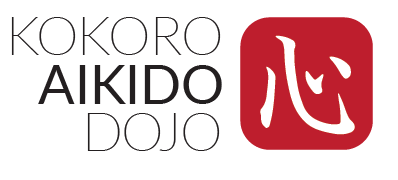Aikido is not a religion, but the education and refinement of the spirit. When we bow during the greeting ceremony it is not a religious performance, but a sign of respect for the same spirit of universal creative intelligence within us all.
• The words spoken at the beginning of practice between the students and instructor are, “Onegai shimasu.” Loosely translated it is a request which when spoken by the student means, “Please give me your instruction.” When spoken by the teacher it means, “Please do what is expected of you.” Or Please receive my instruction.” The words spoken by the student to the instructor at the end of practice are, “Domo arigato gozaimashita.” “You have my respect and gratitude for what you have just done.” This is the most respectful way of saying thank you.
• Upon entering and leaving the practice area of the dojo (the door of the gymzaal) make a standing bow. Always bow in seiza when stepping on or off the mat in the direction of the shomen.
• A few minutes before class time you should be warmed up and formally seated in quiet meditation to rid your mind of the day’s problems and prepare for study. It is important to be on time for practice and participate in the opening ceremony. If you are unavoidably late you should wait, formally seated beside the mat until the instructor signals his or her permission for you to join the class. Quietly perform a simple seated bow as you get on the mat.
• The only proper way to sit on the mat is in seiza (formal sitting position). If you have a knee injury you may sit cross-legged, but never with legs outstretched or reclining.
• Do not leave the mat during class except in the case of injury or illness.
• During class when the instructor demonstrates a technique for practice, sit quietly and attentively in seiza. After the demonstration bow to the instructor, then to a partner and immediately begin to practice.
• When the end of a technique is signaled, stop immediately, bow to your partner and quickly line up with the other students.
• Never stand around idly on the mat. You should be practicing or, if necessary, seated in seiza awaiting your turn.
• If it is necessary to ask a question of the instructor you should go to him or her and bow respectfully (standing bow). Never call the instructor over to you. When receiving personal instruction, sit in seiza and watch intently. Bow formally when the instructor has finished. When another near by is being instructed you may stop your practice to watch. Sit formally and bow as before.
• Respect those more experienced. Never argue about technique. Respect those less experienced. Do not pressure your ideas on others.
• If you understand the movement and are working with someone who does not, you may lead that person through it. Do not attempt to correct or instruct your training partner unless you are authorized to do so by the Teacher in charge.
• Respect your training tools. Gi should be clean and mended. Weapons should be in good condition and in their proper place when not in use.
• Keep talking on the mat to an absolute minimum: discussions or lengthy commentaries are not appropriate during a class. Aikido is experience. Practice at all times with a feeling of Joy.
